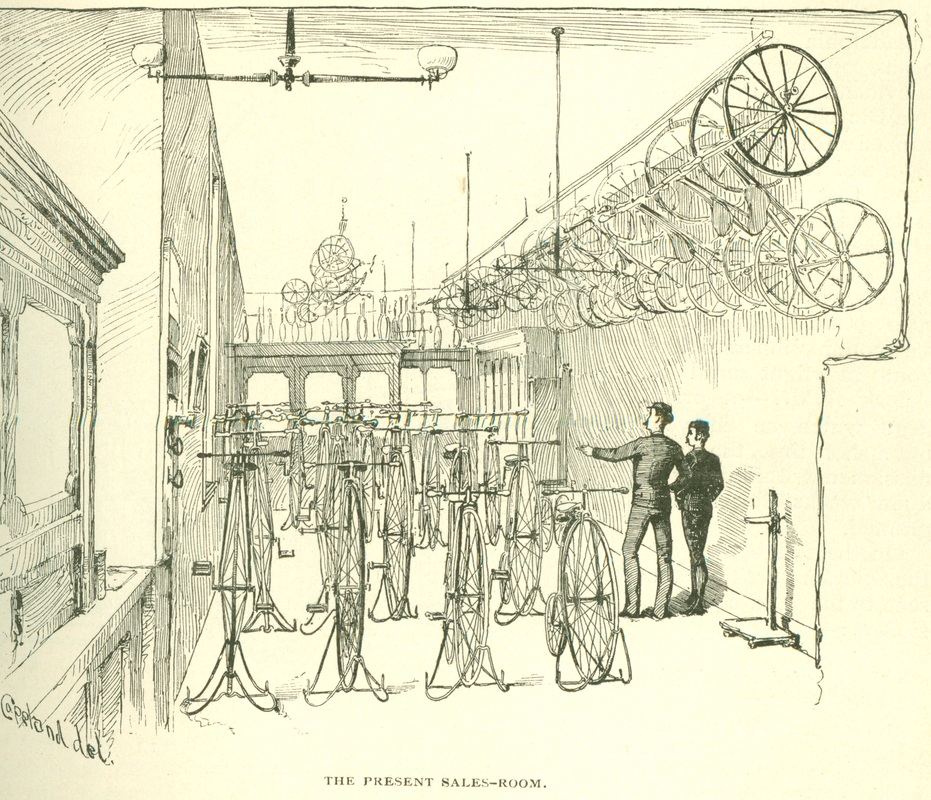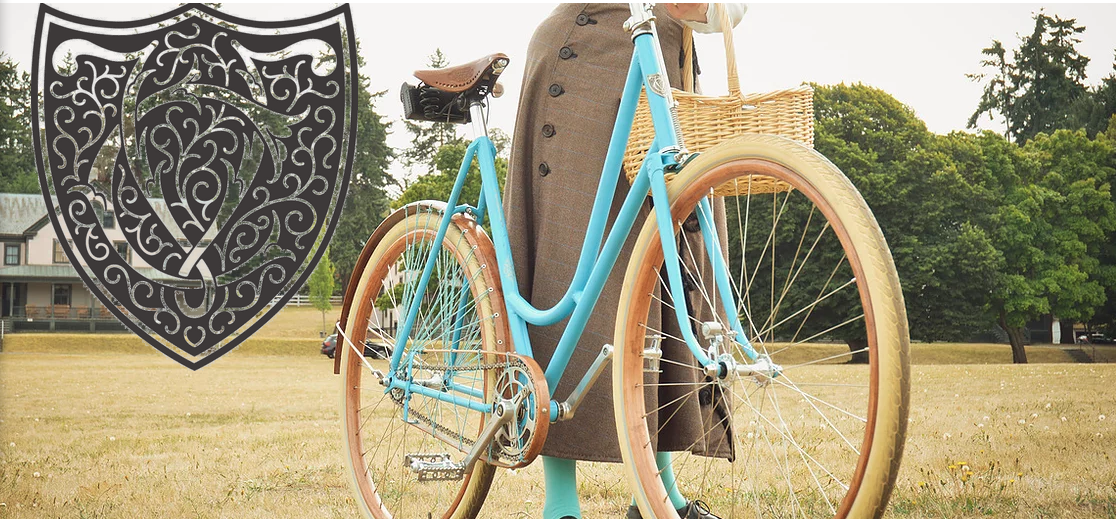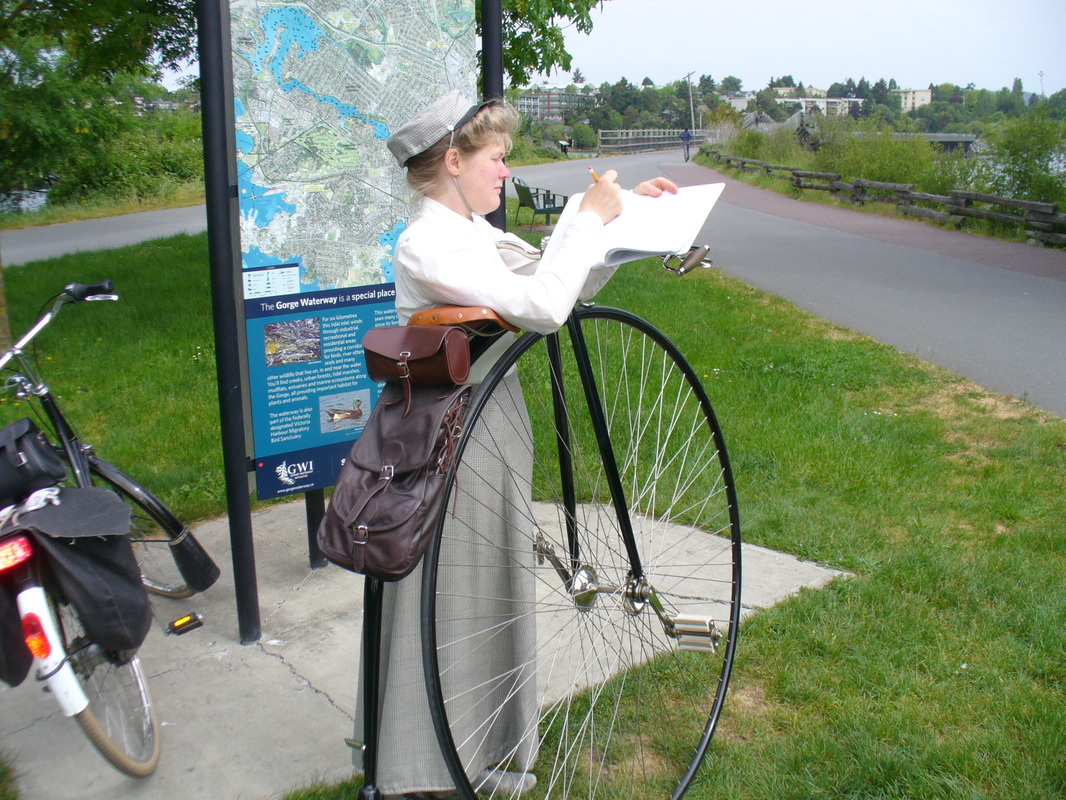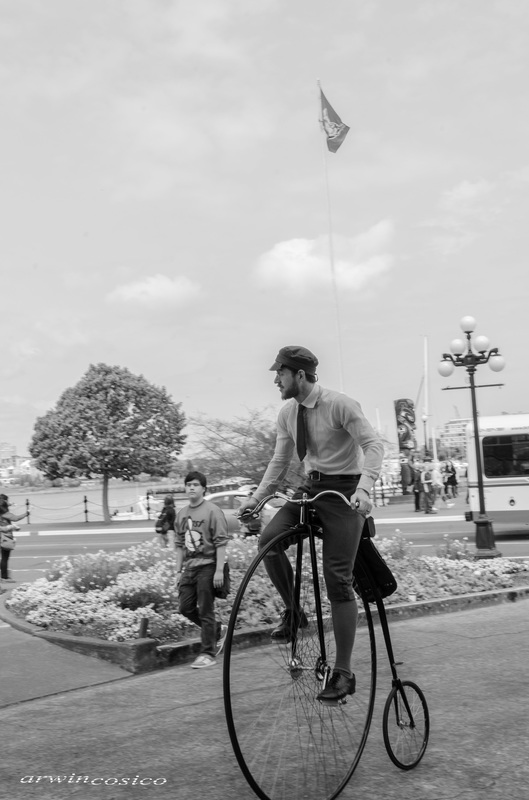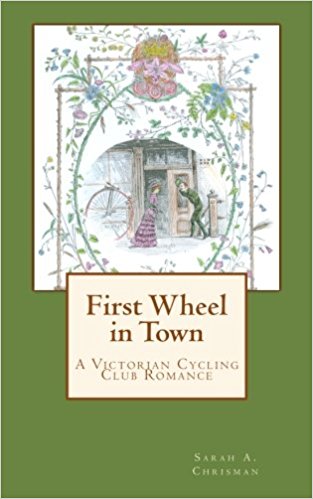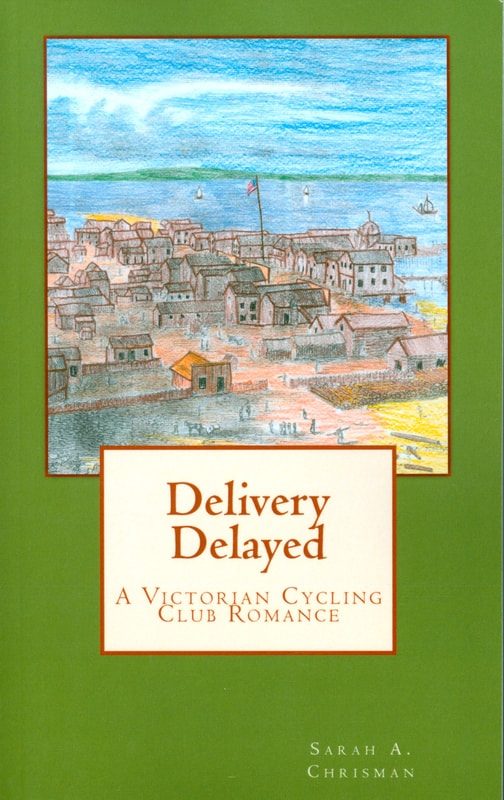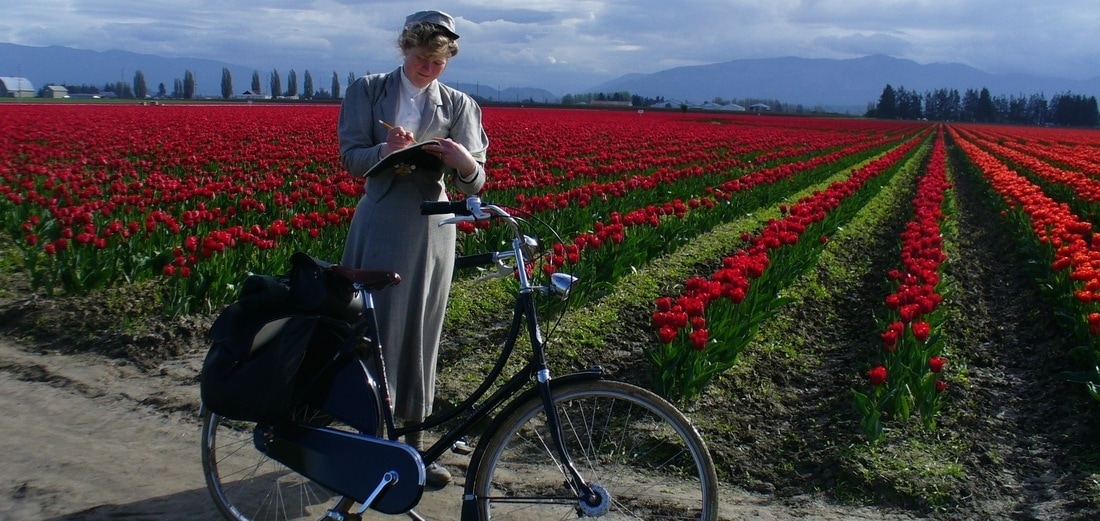Historic Article
The Evolution of a Sport
By F.A. Egan
Godey’s Magazine, April, 1896, pp. 344—348.
Man lives in the present, revels in the future, and occasionally recalls the past, notwithstanding that in the latter there is much that is keenly interesting, much that is highly instructive.
Of the hundreds of thousands who now ride bicycles, how few there are who know of its history, its birth, its growth, its struggles, and its final and far-reaching triumph! Not many really care, perhaps, but for all of that, there are few who will not exhibit at least a show of interest in almost anything which pertains to that which has become so much a part of our daily life that it can well afford to rank as a wonder of the final quarter of the nineteenth century...
In 1865 Pierre Lallemont, a Frenchman, exhibited a bicycle with the cranks and pedals attached to the front wheel, which was also the larger of the two. Previous to that time, the front wheel had always been the smaller. Lallemont’s invention was the forerunner of the “ordinary” or high bicycle, which was so familiar and in such general use twenty years later. In 1868 the rubber tire was introduced, and other improvements followed in time. It was not until 1876, however, that a bicycle, in the general acceptance of the term, was seen in America, and not until the following year that an American, A.D. Chandler, of Boston, was in actual possession of one.
The Englishmen were quicker to realize the advantages of the wheel, and for a time all bicycles used in America were of English make. In 1878, however, a sewing machine company in Hartford, Conn., undertook their manufacture, on a small scale, of course. That it was not a gold mine may be imagined from the fact that one year later the sales of bicycles in this country had reached a total of exactly ninety-two. In November, 1879, there were, by actual census, easily taken, just thirty-five wheels in New York City. A club had been organized during the previous year and a bicycle race run. These attracted notice, and slowly but surely the bicycle crept into favor. There were stumbling-blocks at every corner, however. The “new-fangled thing” frightened horses, nurse-maids, and old women, and was voted a menace to public safety. The law-maker legislated against it, and the common citizen damned it most vigorously. Even as late as 1881 three wheelmen were arrested for daring to ride in Central Park, in New York City. This arrest, however, proved an opening wedge. There were then some one hundred bicycle clubs scattered throughout the country, and the hue and cry that arose resulted in the park authorities removing certain of the restrictions. Cyclists were permitted within the confines of the park after they had proved their proficiency and had been awarded a brass badge, attesting to the fact, by the Park Commissioners...
Until 1886 the high wheel was in general use. The previous year - recall Dalziel’s invention and note how history repeats itself - a low-built bicycle, driven by chain-power, had made its appearance in England, and naturally found its way to this country. It met with immediate disfavor and when, in 1887, a woman’s bicycle was invented by a Washingtonian, the roar that went up... proved such a shock to the public that it was years before it recovered. But it did recover, as all the world now knows.
It is useless to delve deeper into history. The safety, slowly at first, and then with a rush that was amazing, found its way into such favor that the high wheel was soon almost wholly obliterated. The pneumatic tire - invented by a veterinary surgeon, J.B. Dunlop, of Belfast, Ireland - came out in 1889, and completed the “death” of the “ordinary,” although, as a matter of fact, it was not until 1893 that the air tire was fully understood and was in general use.
About the time that the safety bicycle was introduced, interest in cycling was on the wane. The high wheel was hardly a practical machine for all round purposes and for all ages and conditions of men. From its very nature its use must be limited. The low wheel came in at about the proper moment, and was followed by a revival of flagging interest. It was not, however, until the pneumatic tire became known that cycling can be said to have had a really permanent foundation, and to no one other invention is due the present happy condition of things. The new tire wrought a great change in the construction of bicycles, reducing their average weight from fifty to twenty-three pounds; it abridged distances, completely upsetting the old tables of records - witness that it has reduced the mile record from 2:22 3/5 to 1:40 3/5; it permitted travel on streets and roads previously thought unridable, and added to cycling a degree of ease and comfort never dreamed of. Yet how few know how much of this is due to the insistence of an eight-year old boy, Inventor Dunlop’s son?
It is true that as early as 1845 an Englishman named Thompson patented an inflated tire designed for use on wagons, but this was never utilized. It does not appear to have been known to Mr. Dunlop at the time he was experimenting. In simple fashion, he has put the story of his invention in writing, a story which has but seldom seen the light.
“In 1885,” says he, “I bought a tricycle for my only son, John, who was then eight years of age. For a few years previous to that I had been thinking of spring wheels, with the object of reducing vibration, and rendering the propulsion of vehicles comparatively easy.”
“John often complained of the ‘roughness’ or ‘shaking’ he experienced on his tricycle, especially over sets. I understood that spring steel was not reliable in spokes or rims of spring wheels, and I knew that there was a loss of power in heavy rubber tires. I formed the opinion that compressed air contained in a thin, strong, flexible, non-expansible jacket or tube, and applied to the outside of a wheel, would be the best means for increasing speed and reducing vibration of cycles, etc. I told John that I could make the fastest and easiest running machine that had ever been made.
“I was exceedingly busy in the practice of my profession, but John often urged me to have a machine or wheels made according to my ideas. I was anxious to gratify his ardent wishes; besides, I had an ambition to produce a fast machine. I therefore resolved to have an experiment tried. About the end of 1887, or beginning of 1888, I procured two thin strips of American elm about three inches broad, which I bent and formed into rims. I also ordered a few yards of sheet rubber, one-thirty-second of an inch thick, and rubber solution, and bought a few yards of strong Drogheda linen. Out of these we made two air-tubes and tires complete, and secured [the] same to the wooden rims. The tread surface of the canvas tube was covered with two or three layers of the sheet rubber, and a single layer was used near the rims. As we had no workshop these operations were carried on by John and myself in a bed-room seldom used.
“The rims and tires were then suspended round the driving-wheels of the tricycle by means of wires. I did not use an air-tire in the front wheel, because the forks were too narrow, and I had no means of altering them.
“It would take too long a time to describe how these tires were the subject of ridicule and laughter. However, they realized our expectations, and I resolved to have a better tricycle fitted with air-tires.
“When the rubber makers were requested to make the air-tubes, they replied to their Belfast agent that they had been asked to make many absurd things before, but this was the most absurd and impracticable idea they had ever heard of. The agent wrote them again to make the air-tubes, and informed them that the idea was not impracticable, as a pair of such tires were actually in regular use. The bicycle was regularly ridden during the winter, in order to test the tires.”
Thereafter young and old, high and low, male and female caught the infection, until to-day the man or woman who would deride the bicycle would be at once, and rightly, set down as a dyspeptic crank.
The wonderful demand for bicycles which developed during 1895 - a demand so great and wholly unexpected that the bicycle factories of this country, working night and day, could not supply it - is not without parallel. Indeed, the history of the bicycle in America can best be likened to a series of great waves, this, of course, assuming that the curious and fantastic two-wheeled and man-propelled vehicles of the distant past may with propriety be termed “bicycles.”
The first wave reached its greatest height in 1819. Quotations from a publication of that year state that “excitable citizens were in an ecstasy of astonishment and delight over the introduction of the ‘dandy horses,’” and that “the manufacturers could not apparently meet the demand of the ‘velocipeders.’” As with all waves, this receded, and “the people who had purchased machines at great prices gave them away as playthings to grown-up boys.”
In 1868 - 69 another cycling wave precipitated itself on these shores and swept the country from end to end. The velocipede factories worked overtime but could not equal the demand; “riding academies” were over-numerous; “velocipede receptions” were nightly occurences and attracted the fashionable element. At one of the “receptions,” it is recorded that “Among the gentlemen who gave proof of their skill was Charles A. Dana, who is an expert rider.”
This reprint from a record of 1868 is of unusual interest at this time and shows how closely history has repeated and is repeating itself:
“Several months have passed since we heard of a two-wheeled contrivance, called ‘bicircle’ [sic] or ‘veloce’ by which it was possible for an active Frenchman to traverse ten miles of the streets of Paris in a single hour. The fever which raged so high there seems to have broken out in America. Schools for the instruction of velocipede-riding are being opened. Youngsters ride down Fifth Avenue with their school-books strapped in front of their velocipedes, and expert riders cause crowds of spectators to visit the public squares, which afford excellent tracks for the light wheels to move swiftly over. The Rev. Henry Ward Beecher has secured two of the American machines, and other gentlemen, well known in the literary and artistic world, are possessed of their magic circles. One of them takes his ride of nearly ten miles daily, and saves time as well as enjoying the ride. A number of persons are already making use of the velocipede as a means of traversing the distance between their homes and places of business. Professional inventors are now loboring to bring it to American completeness, and the few dealers in New York are doing quite a driving business. Their prices range from $60 to $100, about the same as in France. The weight of a medium sized machine is about sixty pounds, and the size of driving-wheel most in favor from thirty to thirty-six inches. The winter season is not favorable to veloce-riding, but with the opening of spring we may expect to see the two-wheeled affairs gliding gracefully about the streets and whizzing swiftly through the smooth roads of Central Park.”
Whether it is proper to term the 1895 demand a wave is, of course, open to serious question. If it is, it certainly has not reached its height. The greatly increased outputs of the various factories, and the intense displayed by the public in the several cycle shows of the past few months, make this appear certain. That is not a “wave,” that it will not recede, that the present demand is not a “craze” nor a “mania,” there is abundant reason to believe. That the sudden and sky-rockety increase last year was unnatural is generally admitted. That the business will continue to grow is certain, but that it must settle down to a strictly commercial basis is equally true.
Let not the bicycle be confounded or too closely linked with the so-called “motocycle” [sic]- a general inclination of this time. The two vehicles are too disimilar in purpose and in accomplishment to be placed in the same class. It is the bicycle, the vehicle propelled by human energy, that is making the world better and healthier and more contented, and which deserves the praise. It has abridged distance - which accomplishment, the sages say, is second only to the invention of the alphabet - but better still, perhaps, it is making a happier and healthier people. It has, to an extent, broken down the barrier between classes, and has contributed to the home circle a means of contentment by which there may be a more nearly equal division of the joys, a division which may be shared by father and son, by mother and daughter. Every revolution of the pedals means a breath of new air, an infusion of new blood, a quickening of the energies, a bettering of the mind, a bettering of the body; all of which have a direct bearing on the affairs of home and business.
The bicycle has brought the world one step closer to Nature.
Of the hundreds of thousands who now ride bicycles, how few there are who know of its history, its birth, its growth, its struggles, and its final and far-reaching triumph! Not many really care, perhaps, but for all of that, there are few who will not exhibit at least a show of interest in almost anything which pertains to that which has become so much a part of our daily life that it can well afford to rank as a wonder of the final quarter of the nineteenth century...
In 1865 Pierre Lallemont, a Frenchman, exhibited a bicycle with the cranks and pedals attached to the front wheel, which was also the larger of the two. Previous to that time, the front wheel had always been the smaller. Lallemont’s invention was the forerunner of the “ordinary” or high bicycle, which was so familiar and in such general use twenty years later. In 1868 the rubber tire was introduced, and other improvements followed in time. It was not until 1876, however, that a bicycle, in the general acceptance of the term, was seen in America, and not until the following year that an American, A.D. Chandler, of Boston, was in actual possession of one.
The Englishmen were quicker to realize the advantages of the wheel, and for a time all bicycles used in America were of English make. In 1878, however, a sewing machine company in Hartford, Conn., undertook their manufacture, on a small scale, of course. That it was not a gold mine may be imagined from the fact that one year later the sales of bicycles in this country had reached a total of exactly ninety-two. In November, 1879, there were, by actual census, easily taken, just thirty-five wheels in New York City. A club had been organized during the previous year and a bicycle race run. These attracted notice, and slowly but surely the bicycle crept into favor. There were stumbling-blocks at every corner, however. The “new-fangled thing” frightened horses, nurse-maids, and old women, and was voted a menace to public safety. The law-maker legislated against it, and the common citizen damned it most vigorously. Even as late as 1881 three wheelmen were arrested for daring to ride in Central Park, in New York City. This arrest, however, proved an opening wedge. There were then some one hundred bicycle clubs scattered throughout the country, and the hue and cry that arose resulted in the park authorities removing certain of the restrictions. Cyclists were permitted within the confines of the park after they had proved their proficiency and had been awarded a brass badge, attesting to the fact, by the Park Commissioners...
Until 1886 the high wheel was in general use. The previous year - recall Dalziel’s invention and note how history repeats itself - a low-built bicycle, driven by chain-power, had made its appearance in England, and naturally found its way to this country. It met with immediate disfavor and when, in 1887, a woman’s bicycle was invented by a Washingtonian, the roar that went up... proved such a shock to the public that it was years before it recovered. But it did recover, as all the world now knows.
It is useless to delve deeper into history. The safety, slowly at first, and then with a rush that was amazing, found its way into such favor that the high wheel was soon almost wholly obliterated. The pneumatic tire - invented by a veterinary surgeon, J.B. Dunlop, of Belfast, Ireland - came out in 1889, and completed the “death” of the “ordinary,” although, as a matter of fact, it was not until 1893 that the air tire was fully understood and was in general use.
About the time that the safety bicycle was introduced, interest in cycling was on the wane. The high wheel was hardly a practical machine for all round purposes and for all ages and conditions of men. From its very nature its use must be limited. The low wheel came in at about the proper moment, and was followed by a revival of flagging interest. It was not, however, until the pneumatic tire became known that cycling can be said to have had a really permanent foundation, and to no one other invention is due the present happy condition of things. The new tire wrought a great change in the construction of bicycles, reducing their average weight from fifty to twenty-three pounds; it abridged distances, completely upsetting the old tables of records - witness that it has reduced the mile record from 2:22 3/5 to 1:40 3/5; it permitted travel on streets and roads previously thought unridable, and added to cycling a degree of ease and comfort never dreamed of. Yet how few know how much of this is due to the insistence of an eight-year old boy, Inventor Dunlop’s son?
It is true that as early as 1845 an Englishman named Thompson patented an inflated tire designed for use on wagons, but this was never utilized. It does not appear to have been known to Mr. Dunlop at the time he was experimenting. In simple fashion, he has put the story of his invention in writing, a story which has but seldom seen the light.
“In 1885,” says he, “I bought a tricycle for my only son, John, who was then eight years of age. For a few years previous to that I had been thinking of spring wheels, with the object of reducing vibration, and rendering the propulsion of vehicles comparatively easy.”
“John often complained of the ‘roughness’ or ‘shaking’ he experienced on his tricycle, especially over sets. I understood that spring steel was not reliable in spokes or rims of spring wheels, and I knew that there was a loss of power in heavy rubber tires. I formed the opinion that compressed air contained in a thin, strong, flexible, non-expansible jacket or tube, and applied to the outside of a wheel, would be the best means for increasing speed and reducing vibration of cycles, etc. I told John that I could make the fastest and easiest running machine that had ever been made.
“I was exceedingly busy in the practice of my profession, but John often urged me to have a machine or wheels made according to my ideas. I was anxious to gratify his ardent wishes; besides, I had an ambition to produce a fast machine. I therefore resolved to have an experiment tried. About the end of 1887, or beginning of 1888, I procured two thin strips of American elm about three inches broad, which I bent and formed into rims. I also ordered a few yards of sheet rubber, one-thirty-second of an inch thick, and rubber solution, and bought a few yards of strong Drogheda linen. Out of these we made two air-tubes and tires complete, and secured [the] same to the wooden rims. The tread surface of the canvas tube was covered with two or three layers of the sheet rubber, and a single layer was used near the rims. As we had no workshop these operations were carried on by John and myself in a bed-room seldom used.
“The rims and tires were then suspended round the driving-wheels of the tricycle by means of wires. I did not use an air-tire in the front wheel, because the forks were too narrow, and I had no means of altering them.
“It would take too long a time to describe how these tires were the subject of ridicule and laughter. However, they realized our expectations, and I resolved to have a better tricycle fitted with air-tires.
“When the rubber makers were requested to make the air-tubes, they replied to their Belfast agent that they had been asked to make many absurd things before, but this was the most absurd and impracticable idea they had ever heard of. The agent wrote them again to make the air-tubes, and informed them that the idea was not impracticable, as a pair of such tires were actually in regular use. The bicycle was regularly ridden during the winter, in order to test the tires.”
Thereafter young and old, high and low, male and female caught the infection, until to-day the man or woman who would deride the bicycle would be at once, and rightly, set down as a dyspeptic crank.
The wonderful demand for bicycles which developed during 1895 - a demand so great and wholly unexpected that the bicycle factories of this country, working night and day, could not supply it - is not without parallel. Indeed, the history of the bicycle in America can best be likened to a series of great waves, this, of course, assuming that the curious and fantastic two-wheeled and man-propelled vehicles of the distant past may with propriety be termed “bicycles.”
The first wave reached its greatest height in 1819. Quotations from a publication of that year state that “excitable citizens were in an ecstasy of astonishment and delight over the introduction of the ‘dandy horses,’” and that “the manufacturers could not apparently meet the demand of the ‘velocipeders.’” As with all waves, this receded, and “the people who had purchased machines at great prices gave them away as playthings to grown-up boys.”
In 1868 - 69 another cycling wave precipitated itself on these shores and swept the country from end to end. The velocipede factories worked overtime but could not equal the demand; “riding academies” were over-numerous; “velocipede receptions” were nightly occurences and attracted the fashionable element. At one of the “receptions,” it is recorded that “Among the gentlemen who gave proof of their skill was Charles A. Dana, who is an expert rider.”
This reprint from a record of 1868 is of unusual interest at this time and shows how closely history has repeated and is repeating itself:
“Several months have passed since we heard of a two-wheeled contrivance, called ‘bicircle’ [sic] or ‘veloce’ by which it was possible for an active Frenchman to traverse ten miles of the streets of Paris in a single hour. The fever which raged so high there seems to have broken out in America. Schools for the instruction of velocipede-riding are being opened. Youngsters ride down Fifth Avenue with their school-books strapped in front of their velocipedes, and expert riders cause crowds of spectators to visit the public squares, which afford excellent tracks for the light wheels to move swiftly over. The Rev. Henry Ward Beecher has secured two of the American machines, and other gentlemen, well known in the literary and artistic world, are possessed of their magic circles. One of them takes his ride of nearly ten miles daily, and saves time as well as enjoying the ride. A number of persons are already making use of the velocipede as a means of traversing the distance between their homes and places of business. Professional inventors are now loboring to bring it to American completeness, and the few dealers in New York are doing quite a driving business. Their prices range from $60 to $100, about the same as in France. The weight of a medium sized machine is about sixty pounds, and the size of driving-wheel most in favor from thirty to thirty-six inches. The winter season is not favorable to veloce-riding, but with the opening of spring we may expect to see the two-wheeled affairs gliding gracefully about the streets and whizzing swiftly through the smooth roads of Central Park.”
Whether it is proper to term the 1895 demand a wave is, of course, open to serious question. If it is, it certainly has not reached its height. The greatly increased outputs of the various factories, and the intense displayed by the public in the several cycle shows of the past few months, make this appear certain. That is not a “wave,” that it will not recede, that the present demand is not a “craze” nor a “mania,” there is abundant reason to believe. That the sudden and sky-rockety increase last year was unnatural is generally admitted. That the business will continue to grow is certain, but that it must settle down to a strictly commercial basis is equally true.
Let not the bicycle be confounded or too closely linked with the so-called “motocycle” [sic]- a general inclination of this time. The two vehicles are too disimilar in purpose and in accomplishment to be placed in the same class. It is the bicycle, the vehicle propelled by human energy, that is making the world better and healthier and more contented, and which deserves the praise. It has abridged distance - which accomplishment, the sages say, is second only to the invention of the alphabet - but better still, perhaps, it is making a happier and healthier people. It has, to an extent, broken down the barrier between classes, and has contributed to the home circle a means of contentment by which there may be a more nearly equal division of the joys, a division which may be shared by father and son, by mother and daughter. Every revolution of the pedals means a breath of new air, an infusion of new blood, a quickening of the energies, a bettering of the mind, a bettering of the body; all of which have a direct bearing on the affairs of home and business.
The bicycle has brought the world one step closer to Nature.
Victorian Cycles
Hand-built 1890's-style bicycles
Interested in a real time machine? Commission one of our 1890s-style custom bicycles! Custom, hand-made steel frames with wooden fenders and chainguards, leather saddles and cork grips. Whether you are interested in a roadster or a racer, we can build you the period bicycle of your dreams.
***
Other historic cycling articles:
A Burglar, A Bicycle, and A Storm (Fiction—1896)
A Cycle of the Seasons: A Bicycle Romance in Four Meets (Fiction—1883)
A Cycle Show in Little (1896)
A Header (?) (Poem—1883)
A Modern Love Sung in Ancient Fashion (Poem—1884)
Bicycling and Tricycling (1884)
Cycling for Women (1888)
Cycling's Value As An Exercise (1879)
Is Bicycling Harmful? (1896)
The Evolution of a Sport (1897)
Foreign [Bicycling News] (1884)
On Wings of Love (Poem—1884)
Rosalind A Wheel (Fiction—1896)
Snakes in his Wheel (1895)
The Work of Wheelmen for Better Roads (1896)
Woman's Cycle (1896)
Back to Historical Articles Index
An article about us in Bicycling magazine:
"How To Bike Like A Victorian"
http://www.bicycling.com/culture/people/old-doesn-t-mean-bad-modern-conversation-victorian-era-cyclists
A few of Sarah's accounts of our Victorian cycling adventures:
The flower fields of the Skagit Valley:
http://www.thisvictorianlife.com/blog/my-recent-trip-to-the-skagit-valley
A Trip to A Lavender Festival:
http://www.thisvictorianlife.com/blog/sneak-peek-into-a-future-book
The Tricycle's Maiden Voyage:
http://www.thisvictorianlife.com/blog/the-tricycles-maiden-voyage
The Chilly Hilly ride:
http://www.thisvictorianlife.com/blog/chilly-hilly
Port Townsend to Port Gamble:
http://www.thisvictorianlife.com/blog/port-gamble-wa
Sarah ALWAYS wears a corset—even while cycling. Here's an excerpt from her book about it:
http://www.thisvictorianlife.com/blog/cycling-in-a-corset-a-short-excerpt-from-victorian-secrets
Rebuttal of an erroneous article:
http://www.thisvictorianlife.com/blog/a-rebuttal-to-a-recent-article
In a seaport town in the late 19th-century Pacific Northwest, a group of friends find themselves drawn together —by chance, by love, and by the marvelous changes their world is undergoing. In the process, they learn that the family we choose can be just as important as the ones we're born into. Join their adventures in
The Tales of Chetzemoka
To read about the exhaustive research that goes into each book and see little vignettes from the stories, click on their "Learn More" buttons!
The Wheelman's Joy
Victorian Cycling Poetry and Words About Wheels
There is something inherently romantic about cycling, and there has been since the first riders set their wheels to the road. This collection of nineteenth-century poetry, prose quotes and bon-mots about cycling reflects both the ardent passion and the innocent affection cycling inspires. From the glory days of high-wheel cycling through the boom of the safety bicycle, riders were falling in love with their wheels, with new-found freedoms, and above all with each other. This delightful little collection tells of those days in their own words, and evokes sentiments which every cyclist will find timeless. Compiled edited and introduced by Sarah A. Chrisman, author of the charming Tales of Chetzemoka cycling club series, This Victorian Life, Victorian Secrets, and others.
Victorian
|
True Ladies
|
This
|
For words of wit and advice sage,
I hope you'll like my author page!
History lessons, folks who dare,
Please do share it while you're there!
https://www.facebook.com/ThisVictorianLife
***
If you've found our website helpful, please consider making a cash donation.
Your generous support helps us maintain this website and continue our outreach, so that we can keep teaching others about the history we love.
Everything helps and is appreciated!
Search this website:
***
